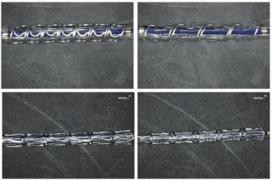Advances in Magnesium-based Materials for Better Implant Applications
Stents are implants used to treat an abnormal connection of blood vessels in the tissues around the brain or spinal cord (known as arteriovenous fistula [AVF]). To develop better-performing implantable stents, researchers at the NSF-funded Engineering Research Center (ERC) for Revolutionizing Metallic Biomaterials (RMB) have created and tested multiple designs using a variety of materials. RMB is headquartered at North Carolina A&T State University (NCAT) with partner institutions including the Universities of Pittsburgh (Pitt) and Cincinnati (UC).
Medical stents are mesh-like metal tubes used to prop open arteries to treat an abnormal constriction. Balloon-expandable stents, one of the two main types of stents, are expanded in the artery by inflating a balloon, which is then removed. Magnesium (Mg) has good biocompatibility for use in medical implants. However, a major drawback is their fast corrosion rate, which causes them to lose their mechanical integrity before the tissues have sufficient time to heal. Nevertheless, the use of Mg alloys as biodegradable implants is seen as promising. In 2018, RMB focused its stent materials research on growing and characterizing Mg alloy single crystals to treat AVF. Using Mg-based alloys from both the ERC’s systems and commercially available Mg alloys like WE43, a single crystal of 6.5 mm in diameter and 50 mm in length was grown and fully characterized. Thanks to the extraordinary ductility of this single crystal, a stent fabricated from this material showed balloon expansion from four to ten millimeters without any damage. Further study also revealed that the Mg single-crystal stents had better corrosion resistance than AZ31 Mg alloy stents.
There are many types of balloon-expandable stents, each designed to treat a specific range of anatomies—most commonly a coronary artery. Balloon-expandable stents are attached to stent-delivery balloon catheters by means of a radial compression process known as stent crimping. As part of RMB’s continuous improvement of stent design through simulation and materials selection, they created a new robust design with rhombus patterns for AZ31 Mg stents. Rhombus design stents have shown great crimpability and uniform balloon expansion when applying strong water pressure and are being tested in vivo for AVF application. Multiple heart valve stents and meshes have been also manufactured by photochemical etching and tested. Photochemical etching was employed for fabricating different designs of zinc (Zn) stents and to test them in the lab. In some cases, a polymer coating was applied by vapor deposition, greatly enhancing the corrosion resistance of both Mg and Zn stents.





